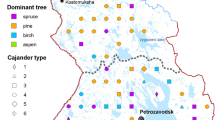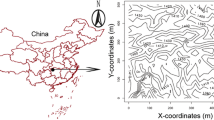Abstract
The mountainous forests in arid regions, being sensitive to climate change, are one of the key research topics related to the mechanism of interaction between climate and the terrestrial ecosystem. In this study, the spatial distribution of a mid-mountain forest and its environmental factors were investigated by using a combination of remote sensing technology, field survey, climate indices and soil nutrient analysis in the Sangong River watershed of the northern Tianshan Mountains. The forest (Picea schrenkiana) was distributed between 1,510 and 2,720 m asl. Tree height and diameter at breast height (DBH) exhibited a bi-modal pattern with increasing elevation, and rested at 2,450 and 2,250 m asl, respectively. The two maxima of DBH appeared at 2,000 and 2,550 m asl, and the taller trees were observed at 2,100 and 2,600 m asl. For the annual mean temperature, the difference was approximately 5.8°C between the lowest and the highest limits of the forest, and the average decreasing rates per hundred meters were 0.49°C and 0.55°C with increasing altitude between 1,500 and 2,000 m asl and above 2,000 m asl, respectively. The annual precipitation in the forest zone first increased and then decreased with the increase of altitude, and the maximum value was at 2,000 m asl. For per hundred meters, the annual precipitation increased with the rate of 31 mm between 1,500 and 2,000 m asl and decreased by 7.8 mm above 2,000 m asl. The SOM, TN and TP were high between 2,000 and 2,700 m asl and low at the lower and upper forest limits. The minimum CaCO3 concentration, pH value and EC coincided with the maximum precipitation belt at 2,000 m asl. The SOM, TN and TP were high in the topsoil (0–10 cm) and differed significantly from the values observed in the deep soil layers (>10 cm). The soil nutrients exhibited spatial heterogeneity and higher aggregation in the topsoil. In conclusion, soil and climate are closely related to each other, working synergistically to determine the development and spatial distribution of the mid-mountain forest in the study area. The order of the importance of environmental factors to forest development in this study is as follows: soil nutrients>precipitation>elevation>temperature.
Similar content being viewed by others
References
Chang Z H, Sun J K. 1995. Forest Soil of Xinjiang Mountain Region. Urumqi: Xinjiang Health Science and Technology Publishing House. (in Chinese)
Chen S Y, Guo J Y, Han T, et al. 2009. Climate warming of autumn air temperature in arid and semiarid regions in Northwest China over the recent 46 years. Journal of Desert Research, 29(3): 544–550. (in Chinese)
Chen X, Xu W Q, Luo G P, et al. 2008. Soil properties at the tree limits of Picea schrenkiana forests in response to varying environmental conditions on the northern slope of Tianshan mountains. Acta Ecologica Sinica, 28(1): 53–61. (in Chinese)
Dai L, Li Y Z, Luo G P, et al. 2013. The spatial variation of alpine timberlines and their biogeographical characteristics in the northern Tianshan Mountains of China. Environmental Earth Sciences, 68(1): 129–137.
Fall P L. 1997. Timber fluctuation and late Quaternary paleoclimates in the Southern Rocky Mountains, Colorado. Geological Society of America Bulletin, 109(10): 1306–1320.
Germino M J, Smith W K, Resor A C. 2002. Conifer seedling distribution and survival in an alpine-treeline ecotone. Plant Ecology, 162: 157–168.
Grace J. 1987. Climatic tolerance and the distribution of plants. New Phytologist, 106(suppl.): 113–130.
He J C, Luo T X, Xu Y Q. 2009. Characteristics of eco-climate at smith fir timberline in the Sergyemla Mountains, Southeast Tibetan Plateau. Acta Ecologica Sinica, 29(1): 37–46. (in Chinese)
Hoch G, Popp M, Körner C H. 2002. Altitudinal increase of mobile carbon pools in Pinus cembra suggests sink limitation of growth at the Swiss treeline. Oikos, 98(2): 361–374.
Hu R J. 2004. The Physical Geography of Tianshan Mountains in China. Beijing: China Environment Science Publishing House. (in Chinese)
Huang C Y. 2008. Pedology. Beijing: China Agriculture Press. (in Chinese)
Institute of Soil Sciences, Chinese Academy of Sciences. 1978. Analysis of Soil Physics and Chemistry. Shanghai: Shanghai Science and Technology Press. (in Chinese)
Körner C, Paulsen J. 2004. A world-wide study of high altitude treeline temperatures. Journal of Biogeography, 31(5): 713–732.
Li X, Huang C L, Che T, et al. 2007. Development of a Chinese land data assimilation system: its progress and prospects. Progress in Natural Science, 17(2): 163–173.
Li Y D. 1997. Community Characteristics of Tropical Mountain Rain Forest in Jianfengling, Hainan Island. Journal of Tropical and Subtropical Botany, 5(1): 18–26. (in Chinese)
Liston G E, Elder K. 2006. A meteorological distribution system for high-resolution terrestrial modeling (MicroMet). Journal of Hydrometeorology, 7(2): 217–234.
Luo G P, Xu W Q, Chen X. 2005. Effect of different land-use systems on soil properties in the Alluvial Plain-oasis in the Arid Land. Acta Geographica Sinica, 60(5): 779–790. (in Chinese)
Luo R Y. 1983. Forest Soil Science (Problems and Methods). Beijing: Science Press. (in Chinese)
Nicholson S E 2001. Application of remote sensing to climatic and environmental studies in arid and semi-arid lands. Geoscience and Remote Sensing Symposium, IGARSS’ 01. IEEE 2001 International, 3: 985–987.
Njoku E G, Jackson T J, Lakshmi V, et al. 2003. Soil moisture retrieval from AMSR-E. IEEE Transactions on Geoscience and Remote Sensing, 41(2): 215–329.
Peng J F, Gou X H, Chen F H, et al. 2006. The responses of growth ring width variations of Larix sibirica Ledb to climatic change in eastern Tianshan Mountains. Acta Ecologica Sinica, 26(8): 2723–2731. (in Chinese)
Qi Z M, Wang K Y, Song G Y, et al. 2004. Bio-chemical properties of the forest floor in subalpine bamboo communities in western Sichuan. Acta Ecologica Sinica, 24(6): 1230–1236. (in Chinese)
Qin D H, Ding Y H, Su J L, et al. 2005. Assessment of climate and environment changes in China (I): climate and environment changes in China and their projection. Advances in Climate Change Research, 1(1): 4–9. (in Chinese)
Sang W G, Wang Y X Su H X, et al. 2007. Response of tree-ring width to rainfall gradient along the Tianshan Mountains of northwestern China. Chinese Science Bulletin, 52(21): 2954–2962.
Scuderi L A. 1987. Late-Holocene upper timberline variation in the southern Sierra Nevada. Nature, 325: 242–244.
Shi P, Körner C H, Hoch G. 2008. A test of the growth-limitation theory for alpine tree line formation in evergreen and deciduous taxa of the eastern Himalayas. Functional Ecology, 22: 213–220.
Shi P L, Li W H, Wang J X, et al. 2000. Species-abundance relation of herb communities in subalpine timber-line ecotone of Wolong Natural Reserve, Sichuan Province, China. Acta Ecologica Sinica, 20(5): 384–389. (in Chinese)
Shi Y F, Shen Y P, Hu R J. 2002. Preliminary study on signal, impact and foreground of climatic shift from warm-dry to warm-humid in Northewest China. Journal of Glaciology and Geocryology, 24(3): 219–226. (in Chinese)
Tranquillini W. 1979. Physiological Ecology of Alpine Timberline. Berlin: Springe-Verlag.
Wang X P, Zhang L, Fang J Y. 2004. Geographical Differences in Alpine Timberline and Its Climatic Interpretation in China. Acta Geographica Sinica. 59(6): 871–879. (in Chinese)
Yu P T, Liu H Y, Cui H T. 2002. Vegetation and its relation with climate conditions near the timberline of Beitai, the Xiaowutai Mts., northern China. Chinese Journal of Applied Ecology, 13(5): 523–528. (in Chinese)
Zhang B P, Zhou C H, Chen X P. 2003. The geo-info-spectrum of montane altitudinal belts in China. Acta Geographica Sinica, 58(2): 163–171. (in Chinese)
Zhang W R. 1986. China Forest Soil. Beijing: Science Press. (in Chinese)
Zhang Y, Kong Z C, Yan S, et al. 2006. Fluctuation of Picea timberline and paleo-environment on the northern slope of Tianshan Mountains during the Late Holocene. Chinese Science Bulletin, 51(14): 1747–1756.
Zhao C Y, Feng Z D, Liu Y. 2003. Study on one of ecological services of forest ecosystem in arid region water resource conservation. Journal of Mountain Science, 21(2): 157–161. (in Chinese)
Zhu H F, Wang L L, Shao X M, et al. 2004. Tree ring-width response of Picea schrenkiana to climate change. Acta Geographica Sinica, 59(6): 863–870. (in Chinese)
Author information
Authors and Affiliations
Corresponding author
Rights and permissions
About this article
Cite this article
Dai, L., Feng, Y., Luo, G. et al. The relationship between soil, climate and forest development in the mid-mountain zone of the Sangong River watershed in the northern Tianshan Mountains, China. J. Arid Land 7, 63–72 (2015). https://doi.org/10.1007/s40333-014-0073-x
Received:
Revised:
Accepted:
Published:
Issue Date:
DOI: https://doi.org/10.1007/s40333-014-0073-x




